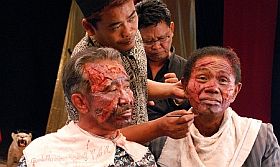


The Documentary Oscar Goes Political/ 3
The nominations have been done. At least three of the films deal with current political conflicts (these ones):
“The Act of Killing”, Cutie and the Boxer, The Square, Dirty Wars and 20 Feet from Stardom compete for the Best Documentary Feature prize at the 86th Academy Awards on March 2…”
I have seen them all (see below) except for “20 Feet from Stardom” (Photo). “The film has this synopsis description on the Oscar site (link below): Background singers heard on many of the 20th century’s greatest songs have made a crucial contribution to the world of pop music while remaining unknown to listeners. The singers take center stage for an in-depth look at their role as supporting figures in the complex process involved in creating the finished recordings.” From watching Youtube clips and the trailer it is obvious that this is a film with wonderful music and women, based on interviews with them and people like Bruce Springsteen, Mick Jagger and Betty Midler. A classic tv language film.
So… who are my favourites having seen all five, one in excerpts? “The Act of Killing” and “The Square” stand out. No doubt about that. In film language, actuality and storytelling. Important films they are. If it comes to approach to theme, innovation and originality “The Act of Killing” is unique. It would get my vote if I was a member of the Academy. I am not.
If you want to read more about what is considered to be the two favourites, not only by me, go to the websites of the films, links below. Or get hold of the magazine DOX 100, where Joshua Oppenheimer and Werner Herzog talk “The Act of Killing” and Jehane Noujaim is interviewed by BBC-editor Nick Fraser about “The Square”. Fraser, who has called “The Act of Killing” “porn for liberals” thinks that “The Square” is “the best film I have seen this year”.
